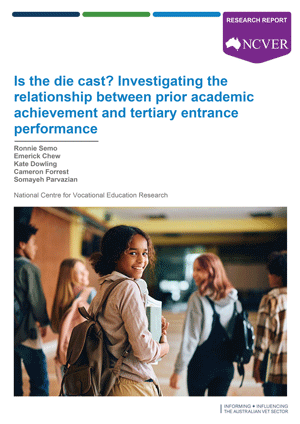Description
This study uses National Assessment Program — Literacy and Numeracy (NAPLAN) data linked with records from the Longitudinal Surveys of Australian Youth (LSAY) to better understand the association between students’ early academic performance at school and their schooling outcomes measured by the Australian Tertiary Admission Rank (ATAR).
Analysis from mixed-effect modelling showed early academic achievement plays an important role in predicting the likelihood of receiving an ATAR and achieving a high ATAR. The study also found that most of the variation in a student’s ATAR performance could be attributed to their demographic profile or academic ability rather than the school they attend.
Summary
Key messages
- As their NAPLAN scores increase, individuals from a high socioeconomic background are almost one and a half times more likely to receive an ATAR than individuals from a low socioeconomic background with the same increase in their NAPLAN score.
- Female students and those with a non-English speaking background are almost twice as likely to receive an ATAR compared to their male peers and those with an English-speaking background respectively, while Indigenous students are about half as likely as non-Indigenous students to receive an ATAR.
- Just two factors are associated with achieving a high ATAR: Year 9 NAPLAN performance and gender – students with higher NAPLAN scores are almost twice as likely to achieve an ATAR score of 90 or above; and female students are also almost twice as likely as males to achieve ATAR scores of 90 or above.
- Schools play a relatively small role in influencing tertiary entrance performance compared with the individual characteristics of the student, with only about 13% of the variation in a student’s tertiary entrance score attributable to the school they attend.
A position of socioeconomic advantage alone does not translate to exceptional academic success. Instead, strong reading and numeracy skills are key, regardless of a student’s background.
Download
| TITLE | FORMAT | SIZE | |
|---|---|---|---|
| Is the die cast? Investigating the relationship between prior academic achievement and tertiary entrance performance | 675.4 KB | Download | |
| Is the die cast? Investigating the relationship between prior academic achievement and tertiary entrance performance | .docx | 1008.8 KB | Download |
| Related report: Understanding and using the linked LSAY-NAPLAN data: issues and considerations | 732.4 KB | Download | |
| Related report: Linking NAPLAN scores to the Longitudinal Surveys of Australian Youth | 1.9 MB | Download |
Related items
A new report released today by the National Centre for Vocational Education Research (NCVER) explore… Show more
